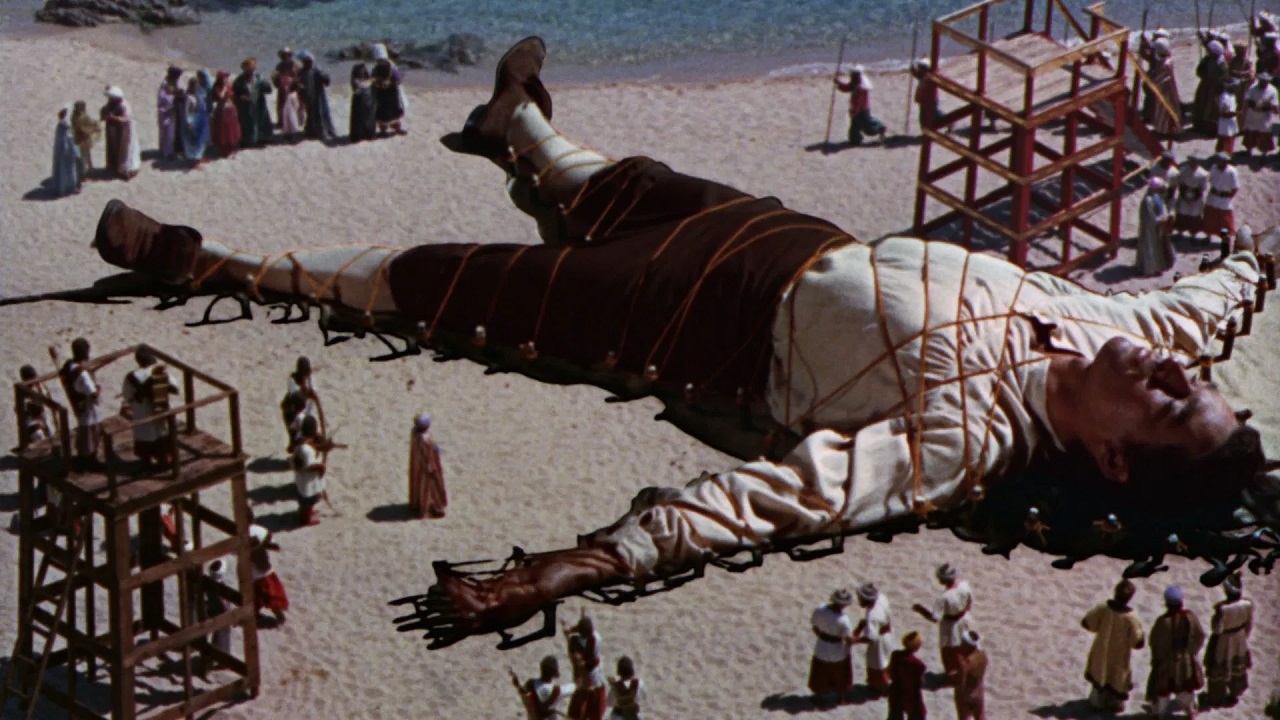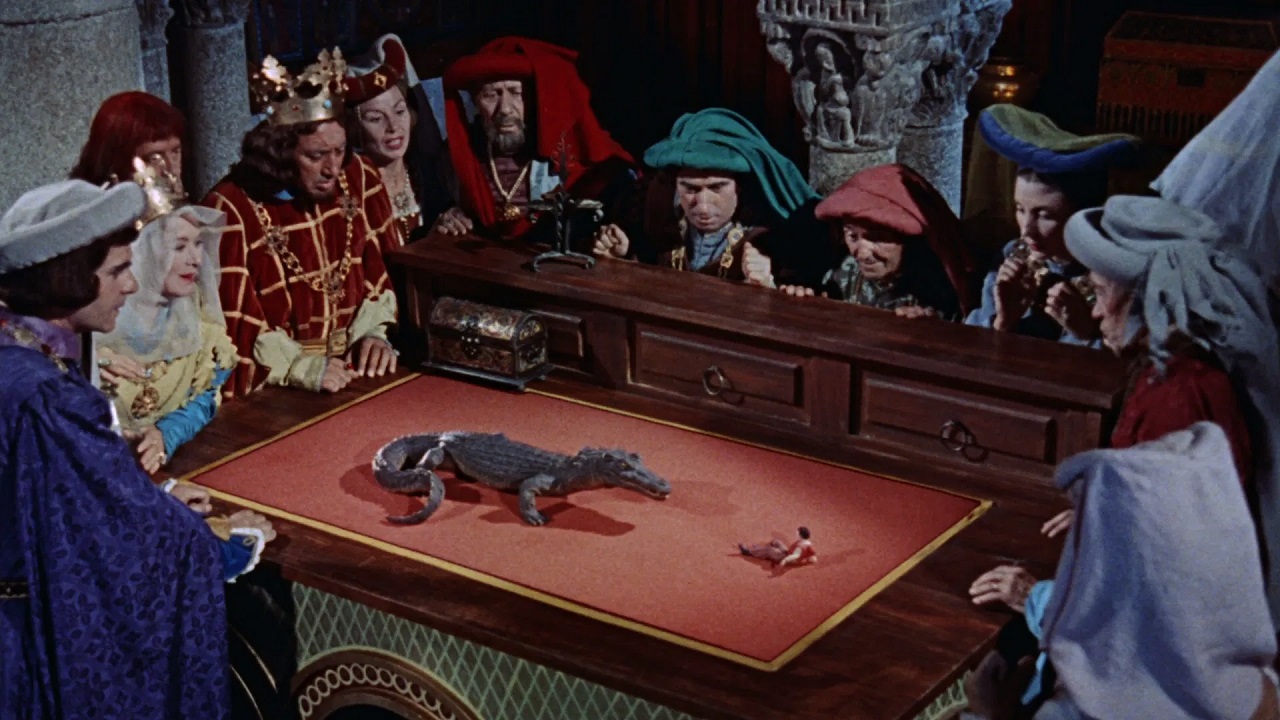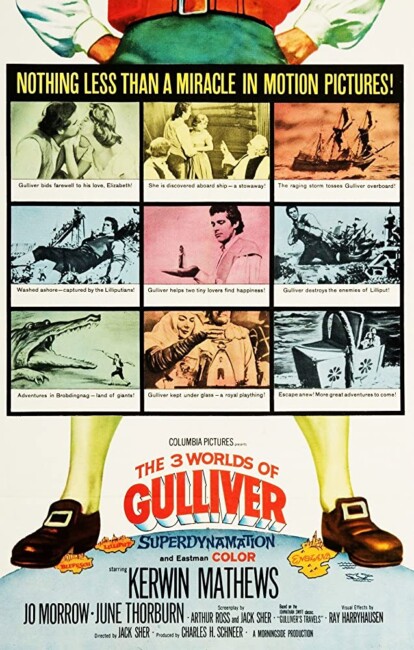USA. 1960.
Crew
Director – Jack Sher, Screenplay – Jack Sher & Arthur Ross, Based on the Novel Gulliver’s Travels by Jonathan Swift, Producer – Charles H. Schneer, Photography – Wilkie Cooper, Music – Bernard Herrmann, Visual Effects Supervisor – Ray Harryhausen, Art Direction – Derek Barrington & Gil Parrendo. Production Company – Morningside Productions.
Cast
Kerwin Mathews (Dr Lemuel Gulliver), June Thorburn (Elizabeth Wesley), Sherri Alberoni (Glumdalclitch), Gregoire Aslan (King Brobdingnag), Lee Patterson (Reldresal), Basil Sydney (Emperor), Charles Lloyd Pack (Makovan), Martin Benson (Flimnap), Marian Spencer (Empress), Mary Ellis (Queen), Jo Morrow (Gwendolyn Bermogg), Peter Bull (Lord Bermogg)
Plot
In 1699, Lemuel Gulliver takes a job at sea because he cannot earn enough money as a doctor. His fiancée Elizabeth stows away with him. Gulliver is then washed away during a storm. He comes around to find himself in the land of Lilliput where he is a giant compared to the tiny Lilliputians. He is seen as a pawn in the Emperor’s war with the neighbouring country Blefuscu, which is being fought over whether people should cut open their eggs from the top or the bottom. Gulliver then sails on to the land of Brobdingnag where he is now tiny and the natives are giants. There he is reunited with Elizabeth and both become a source of fascination to the royal court. However, the advisor Makovan then seeks to have Gulliver tried as a witch.
The 3 Worlds of Gulliver was the second English-language film made of Jonathan Swift’s Gulliver’s Travels (1726). The film reiterates the popular misapprehension that Jonathan Swift wrote the original as a children’s book. Swift’s original story is filled with biting satire and an often bawdy writing style. This version plays it as a simple fabulist adventure where the hero is alternately a giant and then a little person.
Like most other film versions, The 3 Worlds of Gulliver also only tells half the Jonathan Swift book. The book comprises of five journeys – the well known ventures through the lands of Lilliput and Brobdingnag but in most filmed versions the other two sections, the journeys to the floating island of Laputa, inhabited by scientists, and the lands of the Houyhnhnms, inhabited by intelligent horses, are usually thrown out.
The 3 Worlds of Gulliver was made by cult stop motion animator Ray Harryhausen and his producer Charles H. Schneer, who had both just come from the enormous success of The 7th Voyage of Sinbad (1958). They cast the story as the same type of Cinemascope epic that The 7th Voyage of Sinbad was. (See below for Ray Harryhausen’s other films). Kerwin Mathews, who was also Sinbad in 7th Voyage, is miscast as Gulliver – he is all wooden heroics whereas Gulliver is a role that requires more in the way of intellectual prowess

Unfortunately, the Swiftian satire does not sit at ease with this. Nevertheless, despite being scaling up as a big screen adventure, the film allows some of Jonathan Swift’s social absurdities to show through. The pomposities of the Lilliputians and the Brobdingnagians do come across with a certain jolly amusement. At its worst – as in the scenes with the Lilliputian ministers – The 3 Worlds of Gulliver descends to clumsy lowbrow clowning, but these are not too many.
The 3 Worlds of Gulliver is celebrated as part of the great Harryhausen canon but surprisingly Ray Harryhausen’s work does not feature much. He only animates (not very well) a gopher and (extremely well) a giant crocodile. However, these creations are relatively minor and not the focus of the story – for once the story is enough to stand on its own rather than as a showcase of Ray Harryhausen’s effects. The effects work that allows Gulliver to be tied down, to sit at a table as miniature pigs are winched up to him in on a pulley, his towing the Blefuscu ships over his shoulder and the like are all excellent. Frequent Harryhausen collaborator Bernard Herrmann delivers another fine score.Other versions of Gulliver’s Travels are:– Georges Melies’s Gulliver’s Travels Among the Lilliputians and the Giants (1902); Segundo de Chomon’s Gulliver in the Land of the Giants (1903); a Russian version The New Gulliver (1934); Max Fleischer’s animated version Gulliver’s Travels (1939); a Japanese anime version Gulliver’s Travels Beyond the Moon (1965); a live-action Czech version in 1970; a live-action Hungarian version for tv in 1974: Gulliver’s Travels (1977), a partially animated Belgian version starring Richard Harris; Gulliver in Lilliput (1982), a four-part BBC tv version; The Voyages of Gulliver (1983), an animated Spanish version; an American animated tv series Gulliver’s Travels (1992); Gulliver’s Travels (1995), a tv mini-series starring Ted Danson, the finest and most faithful of the adaptations and the only one to cover the entire book; the modernised film version Gulliver’s Travels (2010) starring Jack Black, which played the story as a comedy; and the animated sequel Gulliver Returns (2021).

Ray Harryhausen’s other films are:– The Beast from 20,000 Fathoms (1953), the granddaddy of all atomic monster films; the giant atomic octopus film It Came from Beneath the Sea (1955); the alien invader film Earth Vs. The Flying Saucers (1956); the alien monster film 20 Million Miles to Earth (1957); The 7th Voyage of Sinbad (1958); the Jules Verne adaptation Mysterious Island (1961); the Greek myth adventure Jason and the Argonauts (1963); the H.G. Wells adaptation The First Men in the Moon (1964); the caveman vs dinosaurs epic One Million Years B.C. (1966); the dinosaur film The Valley of Gwangi (1969); the two Sinbad sequels The Golden Voyage of Sinbad (1973) and Sinbad and the Eye of the Tiger (1977); and the Greek myth adventure Clash of the Titans (1981). Ray Harryhausen: Special Effects Titan (2011) was a documentary about his work.
Director Jack Sher had previously made three romantic/dramas with Four Girls in Town (1957), Kathy O’ (1958) and the Western The Wild and the Innocent (1959) and one subsequent film with the musical Love in a Goldfish Bowl (1961). He had far more credits as a writer, particularly in television, although his only other genre credit was as the creator of the short-lived tv series Holmes and Yoyo (1976-7) about a cop and his android partner.
Trailer here

